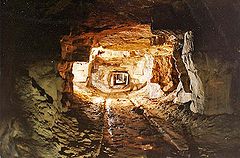Combe Down and Bathampton Down Mines
| Site of Special Scientific Interest | |
 |
|
| Area of Search | Avon |
|---|---|
| Grid reference | ST761625 |
| Coordinates | 51°21′40″N 2°20′41″W / 51.36106°N 2.34465°WCoordinates: 51°21′40″N 2°20′41″W / 51.36106°N 2.34465°W |
| Interest | Biological |
| Area | 15.37 acres (0.0622 km2; 0.02402 sq mi) |
| Notification | 1991 |
| Natural England website | |
Combe Down and Bathampton Down Quarries (grid reference ST761625) make up a 6.22 hectare (15.37 acre) Site of Special Scientific Interest (SSSI) in Bath and North East Somerset, notified in 1991 because of the Greater and Lesser Horseshoe bat population.
The disused quarries dates from the 17th and 18th Century and were used to extract Bath stone for the city of Bath and elsewhere in the UK.
A five-year project to stabilise the quarry workings was largely completed by November 2009.
Combe Down forms a plateau capped by Great Oolite limestones between the valley of the River Avon and Horsecombe Vale. The geology of the region is dominated by rocks of Middle and Early Jurassic ages. The Great Oolite is the uppermost lithology. This is underlain by the clays of the Fuller’s Earth Formation, which in turn is underlain by limestones of the Inferior Oolite and the Midford Sands of the Lias. The Great and Inferior Oolite formations provide effective aquifers (rock in which water can be stored and pass through) for public and private water supplies.
The Great Oolite stone, used for building purposes, formed over 146 million years ago when the area was underneath a deep tropical sea on which ooliths were deposited. The ooliths bonded together to form the distinctive rock known as oolitic limestone or locally as ‘Bath stone’. The Romans found that it was easily worked and used it for important fortifications. During the 17th Century, small quarries were opened, with major quarries being developed in the 18th Century to produce the Bath stone used for many of the buildings in Bath and elsewhere in the UK, including Buckingham Palace. Stone was extracted by the "room and pillar" method, by which chambers were mined, leaving pillars of stone to support the roof. These mines were once owned by Postmaster General Ralph Allen (1694-1764).
...
Wikipedia

